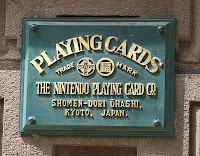
 Recently I've taken a bit of an interest in Yakuza culture and have found myself reading articles here and there with great interest. Today I discovered something that truly amazed me-- that the world's beloved Nintendo video game company has connections to Japan's organised crime syndicates!
Recently I've taken a bit of an interest in Yakuza culture and have found myself reading articles here and there with great interest. Today I discovered something that truly amazed me-- that the world's beloved Nintendo video game company has connections to Japan's organised crime syndicates!In order to explain this rather obscure and fascinating connection, I must first explain the origin of the word, やくざ ("yakuza"). This word comes from a combination of three very old Japanese words from a regional dialect: 八つ ("Yattsu" / Eight) 九 ("Kabu" / Nine) and ざ ("Za" / slang word for 三 or "San" / Three). Yattsu-Kabu-Za ; 8-9-3. Take the abbreviated form of these three words and you get Ya-Ku-Za. Okay, so now that we've established that-- why "8-9-3?"
 8-9-3 goes back to a very old Japanese card game called おいちょかぶ (Oicho-Kabu), which has some slight similarities to Blackjack. The game is not played with western-style playing cards, but with a Japanese 40-card deck called 株札 (Kabufuda). Oicho-Kabu was an integral part of Yakuza illegal gambling rings and became very popular for this reason. In Oicho-Kabu, 8-9-3 is the worst possible hand, and results in a score of Zero (yes, 20 = 0 in this game). Zero, being a losing hand is considered useless, and 8-9-3 or "Ya"-"Ku"-"Za," therefore, was used by regular folks to describe the "useless hands" of society. (Is that amazingly interesting or what!?)
8-9-3 goes back to a very old Japanese card game called おいちょかぶ (Oicho-Kabu), which has some slight similarities to Blackjack. The game is not played with western-style playing cards, but with a Japanese 40-card deck called 株札 (Kabufuda). Oicho-Kabu was an integral part of Yakuza illegal gambling rings and became very popular for this reason. In Oicho-Kabu, 8-9-3 is the worst possible hand, and results in a score of Zero (yes, 20 = 0 in this game). Zero, being a losing hand is considered useless, and 8-9-3 or "Ya"-"Ku"-"Za," therefore, was used by regular folks to describe the "useless hands" of society. (Is that amazingly interesting or what!?) Now that we've completed our history lesson, on to my main point-- Nintendo! What seems like it must be common knowledge to many folks was completely new and fascinating to me as I only found out about it this past weekend. When Nintendo was first founded in Kyoto back in 1889, owner 山内 房治郎 (Yamauchi Fusajiro)'s business was the production and sale of Kabufuda (and also 花札 (Hanafuda)) playing card decks! In fact, each deck of cards was hand-made by Yamauchi-san himself! When he could no longer keep up with the huge demand, he hired some employees to help him and that's how the company grew**. The obvious conclusion, therefore, is that a large percentage of Nintendo's first customers were Yakuza!
Now that we've completed our history lesson, on to my main point-- Nintendo! What seems like it must be common knowledge to many folks was completely new and fascinating to me as I only found out about it this past weekend. When Nintendo was first founded in Kyoto back in 1889, owner 山内 房治郎 (Yamauchi Fusajiro)'s business was the production and sale of Kabufuda (and also 花札 (Hanafuda)) playing card decks! In fact, each deck of cards was hand-made by Yamauchi-san himself! When he could no longer keep up with the huge demand, he hired some employees to help him and that's how the company grew**. The obvious conclusion, therefore, is that a large percentage of Nintendo's first customers were Yakuza!I would like to state, at this point, that I was not able to find any specific sources of information stating that Nintendo's first customers were, indeed, Yakuza. Based on the time period, and the two groups' respective line of work, however, it seems like a fairly obvious conclusion. Please feel free to leave a comment for me if you have any evidence or information that illustrates the opposite.
**Nintendo still makes Hanafuda (flower-card) decks. One of their modern versions has drawings of all the Mario characters on them.
27-May-2011: NEW UPDATE! Further exploration of this topic was recently posted by Brian Ashcraft of Kotaku.com in his review of the book, "The History of Nintendo."








